Strategic Change Management Report: GPDOCS Change Implementation
VerifiedAdded on 2023/01/12
|19
|5614
|89
Report
AI Summary
This report presents a strategic change management analysis for GPDOCS, a government-funded medical practice facing policy changes requiring extended operating hours. The report begins with a stakeholder analysis, identifying and categorizing key stakeholders, followed by an evaluation of potential resistance to change. It then critically examines three management models, including Kotter's Eight-Step Change Model and Lewin's Change Management Model, discussing their advantages, disadvantages, and suitability for GPDOCS. The report also explores the involvement of functional areas in developing a change plan, outlines a strategic change plan based on a selected model, and includes a business memo. The analysis considers the role of change agents and the implications of consulting external agents. The report concludes with recommendations for successful change implementation at GPDOCS, considering the constraints of limited funding and a tight three-month timeframe. The report also includes SMART metrics to measure progress. The report analyzes the role of a change agent and its importance in the process of change management in order to bring transformation.

STRATEGIC CHANGE
MANAGEMENT
MANAGEMENT
Paraphrase This Document
Need a fresh take? Get an instant paraphrase of this document with our AI Paraphraser
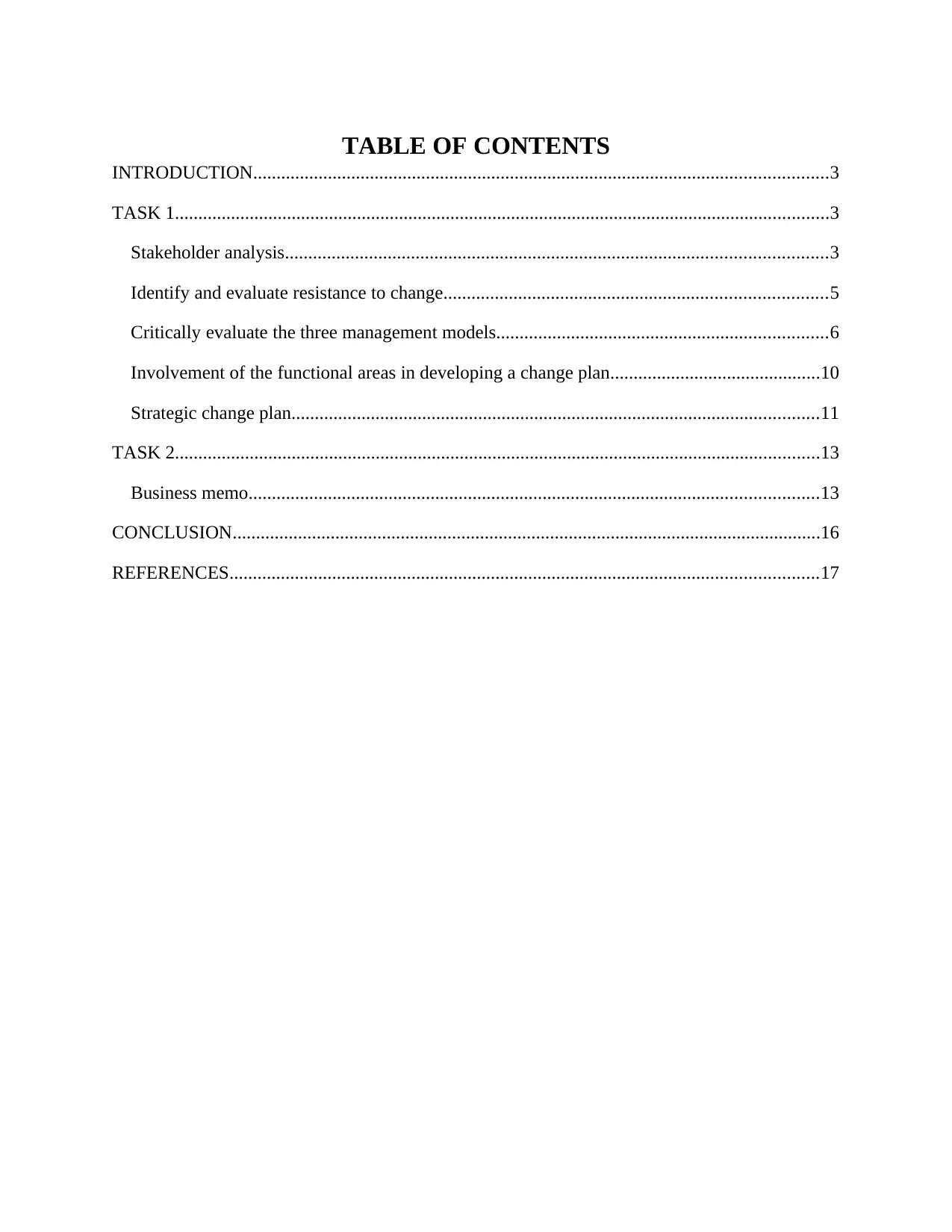
TABLE OF CONTENTS
INTRODUCTION...........................................................................................................................3
TASK 1............................................................................................................................................3
Stakeholder analysis....................................................................................................................3
Identify and evaluate resistance to change..................................................................................5
Critically evaluate the three management models.......................................................................6
Involvement of the functional areas in developing a change plan.............................................10
Strategic change plan.................................................................................................................11
TASK 2..........................................................................................................................................13
Business memo..........................................................................................................................13
CONCLUSION..............................................................................................................................16
REFERENCES..............................................................................................................................17
INTRODUCTION...........................................................................................................................3
TASK 1............................................................................................................................................3
Stakeholder analysis....................................................................................................................3
Identify and evaluate resistance to change..................................................................................5
Critically evaluate the three management models.......................................................................6
Involvement of the functional areas in developing a change plan.............................................10
Strategic change plan.................................................................................................................11
TASK 2..........................................................................................................................................13
Business memo..........................................................................................................................13
CONCLUSION..............................................................................................................................16
REFERENCES..............................................................................................................................17
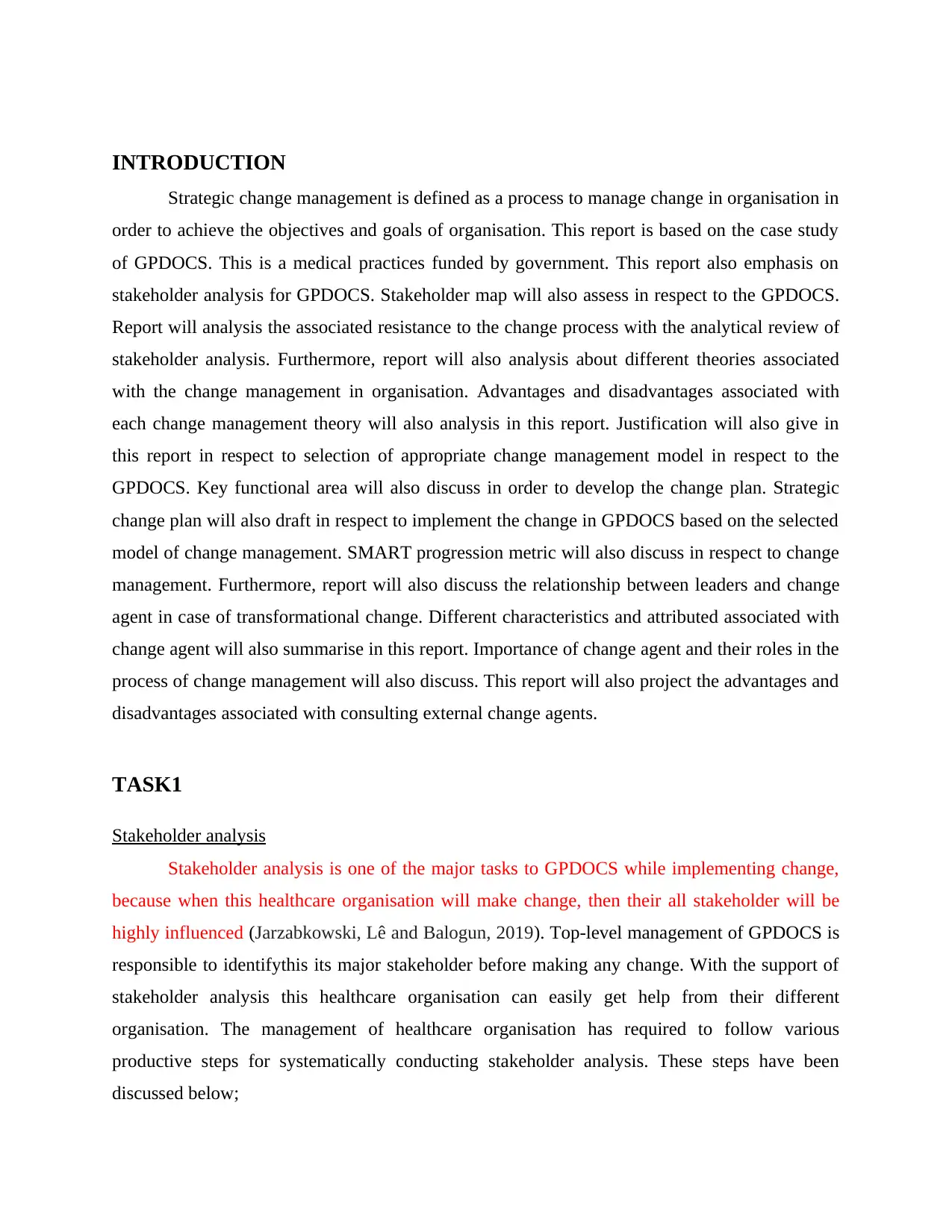
INTRODUCTION
Strategic change management is defined as a process to manage change in organisation in
order to achieve the objectives and goals of organisation. This report is based on the case study
of GPDOCS. This is a medical practices funded by government. This report also emphasis on
stakeholder analysis for GPDOCS. Stakeholder map will also assess in respect to the GPDOCS.
Report will analysis the associated resistance to the change process with the analytical review of
stakeholder analysis. Furthermore, report will also analysis about different theories associated
with the change management in organisation. Advantages and disadvantages associated with
each change management theory will also analysis in this report. Justification will also give in
this report in respect to selection of appropriate change management model in respect to the
GPDOCS. Key functional area will also discuss in order to develop the change plan. Strategic
change plan will also draft in respect to implement the change in GPDOCS based on the selected
model of change management. SMART progression metric will also discuss in respect to change
management. Furthermore, report will also discuss the relationship between leaders and change
agent in case of transformational change. Different characteristics and attributed associated with
change agent will also summarise in this report. Importance of change agent and their roles in the
process of change management will also discuss. This report will also project the advantages and
disadvantages associated with consulting external change agents.
TASK1
Stakeholder analysis
Stakeholder analysis is one of the major tasks to GPDOCS while implementing change,
because when this healthcare organisation will make change, then their all stakeholder will be
highly influenced (Jarzabkowski, Lê and Balogun, 2019). Top-level management of GPDOCS is
responsible to identifythis its major stakeholder before making any change. With the support of
stakeholder analysis this healthcare organisation can easily get help from their different
organisation. The management of healthcare organisation has required to follow various
productive steps for systematically conducting stakeholder analysis. These steps have been
discussed below;
Strategic change management is defined as a process to manage change in organisation in
order to achieve the objectives and goals of organisation. This report is based on the case study
of GPDOCS. This is a medical practices funded by government. This report also emphasis on
stakeholder analysis for GPDOCS. Stakeholder map will also assess in respect to the GPDOCS.
Report will analysis the associated resistance to the change process with the analytical review of
stakeholder analysis. Furthermore, report will also analysis about different theories associated
with the change management in organisation. Advantages and disadvantages associated with
each change management theory will also analysis in this report. Justification will also give in
this report in respect to selection of appropriate change management model in respect to the
GPDOCS. Key functional area will also discuss in order to develop the change plan. Strategic
change plan will also draft in respect to implement the change in GPDOCS based on the selected
model of change management. SMART progression metric will also discuss in respect to change
management. Furthermore, report will also discuss the relationship between leaders and change
agent in case of transformational change. Different characteristics and attributed associated with
change agent will also summarise in this report. Importance of change agent and their roles in the
process of change management will also discuss. This report will also project the advantages and
disadvantages associated with consulting external change agents.
TASK1
Stakeholder analysis
Stakeholder analysis is one of the major tasks to GPDOCS while implementing change,
because when this healthcare organisation will make change, then their all stakeholder will be
highly influenced (Jarzabkowski, Lê and Balogun, 2019). Top-level management of GPDOCS is
responsible to identifythis its major stakeholder before making any change. With the support of
stakeholder analysis this healthcare organisation can easily get help from their different
organisation. The management of healthcare organisation has required to follow various
productive steps for systematically conducting stakeholder analysis. These steps have been
discussed below;
⊘ This is a preview!⊘
Do you want full access?
Subscribe today to unlock all pages.

Trusted by 1+ million students worldwide
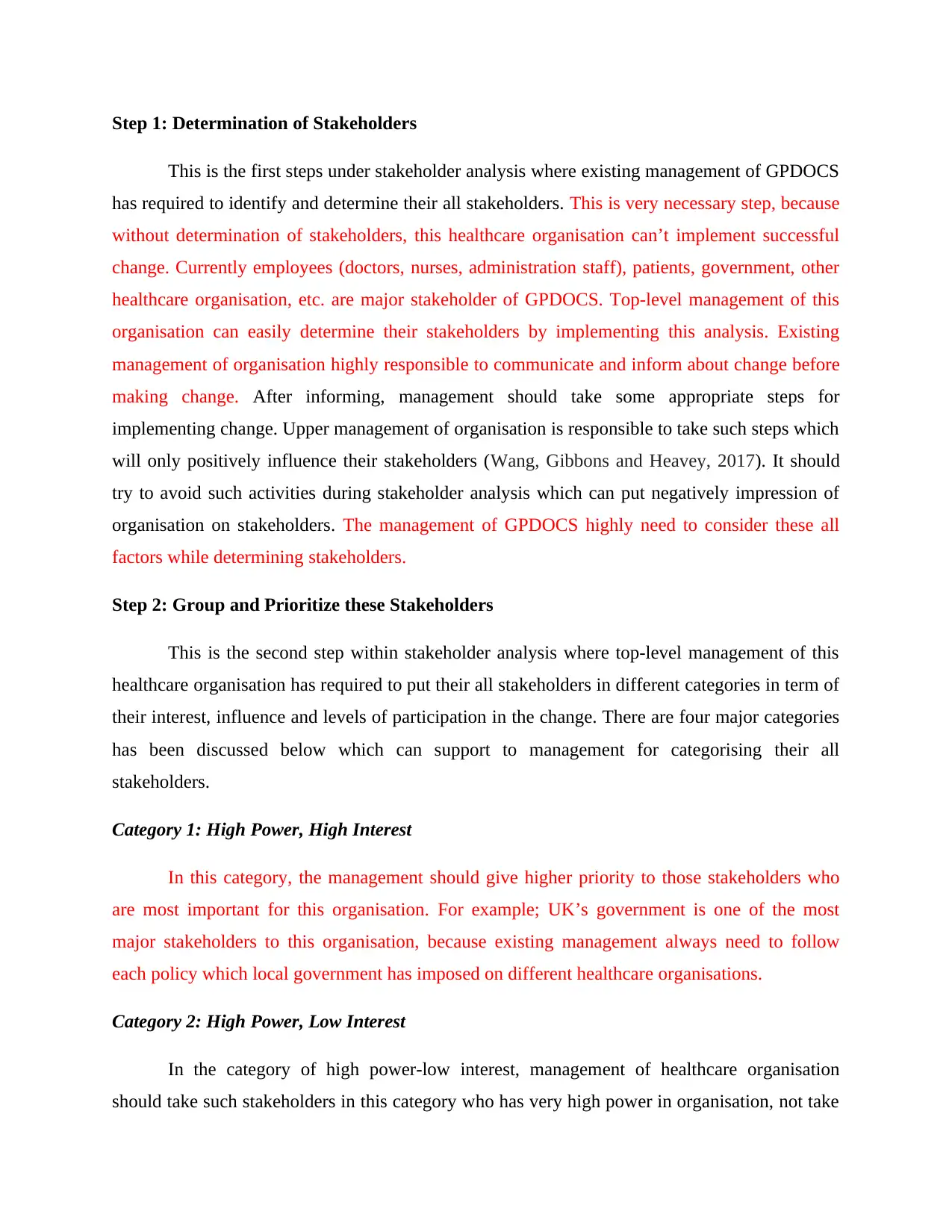
Step 1: Determination of Stakeholders
This is the first steps under stakeholder analysis where existing management of GPDOCS
has required to identify and determine their all stakeholders. This is very necessary step, because
without determination of stakeholders, this healthcare organisation can’t implement successful
change. Currently employees (doctors, nurses, administration staff), patients, government, other
healthcare organisation, etc. are major stakeholder of GPDOCS. Top-level management of this
organisation can easily determine their stakeholders by implementing this analysis. Existing
management of organisation highly responsible to communicate and inform about change before
making change. After informing, management should take some appropriate steps for
implementing change. Upper management of organisation is responsible to take such steps which
will only positively influence their stakeholders (Wang, Gibbons and Heavey, 2017). It should
try to avoid such activities during stakeholder analysis which can put negatively impression of
organisation on stakeholders. The management of GPDOCS highly need to consider these all
factors while determining stakeholders.
Step 2: Group and Prioritize these Stakeholders
This is the second step within stakeholder analysis where top-level management of this
healthcare organisation has required to put their all stakeholders in different categories in term of
their interest, influence and levels of participation in the change. There are four major categories
has been discussed below which can support to management for categorising their all
stakeholders.
Category 1: High Power, High Interest
In this category, the management should give higher priority to those stakeholders who
are most important for this organisation. For example; UK’s government is one of the most
major stakeholders to this organisation, because existing management always need to follow
each policy which local government has imposed on different healthcare organisations.
Category 2: High Power, Low Interest
In the category of high power-low interest, management of healthcare organisation
should take such stakeholders in this category who has very high power in organisation, not take
This is the first steps under stakeholder analysis where existing management of GPDOCS
has required to identify and determine their all stakeholders. This is very necessary step, because
without determination of stakeholders, this healthcare organisation can’t implement successful
change. Currently employees (doctors, nurses, administration staff), patients, government, other
healthcare organisation, etc. are major stakeholder of GPDOCS. Top-level management of this
organisation can easily determine their stakeholders by implementing this analysis. Existing
management of organisation highly responsible to communicate and inform about change before
making change. After informing, management should take some appropriate steps for
implementing change. Upper management of organisation is responsible to take such steps which
will only positively influence their stakeholders (Wang, Gibbons and Heavey, 2017). It should
try to avoid such activities during stakeholder analysis which can put negatively impression of
organisation on stakeholders. The management of GPDOCS highly need to consider these all
factors while determining stakeholders.
Step 2: Group and Prioritize these Stakeholders
This is the second step within stakeholder analysis where top-level management of this
healthcare organisation has required to put their all stakeholders in different categories in term of
their interest, influence and levels of participation in the change. There are four major categories
has been discussed below which can support to management for categorising their all
stakeholders.
Category 1: High Power, High Interest
In this category, the management should give higher priority to those stakeholders who
are most important for this organisation. For example; UK’s government is one of the most
major stakeholders to this organisation, because existing management always need to follow
each policy which local government has imposed on different healthcare organisations.
Category 2: High Power, Low Interest
In the category of high power-low interest, management of healthcare organisation
should take such stakeholders in this category who has very high power in organisation, not take
Paraphrase This Document
Need a fresh take? Get an instant paraphrase of this document with our AI Paraphraser

much interest (Kuipers and Giurge, 2017). It means, stakeholders who has high power and low
interest are mainly comes under this category. Mainly local media comes under this category,
because they can telecast this change new organisation will implement this change.
Category 3: Low Power, High Interest
Those stakeholders mainly come under this category who has low power and high in
interest in this organisation. Currently existing nurses and administration staff best example for
this category, because these employees always have low power and high interest. All staff and
nurses mainly comes under low level management of this healthcare organisation.
Category 4: Low Power, Low Interest
This is the last category within stakeholder analysis where top-level management of
GPDOCS is responsible to put those stakeholders in this category who has low power and low
interest in this healthcare organisation. For example; peons, cleaners etc. are mainly comes under
this category, because they attached with this organisation only for earning some money. But
when management will implement change, then they also get influenced by this change aspect of
organisation.
Step 3: Communicate with Stakeholders
Communicate with stakeholders is the final step within this stakeholder analysis where
existing management of GPDOCS has required to properly communicate with their stakeholders
for informing them about this change. Proper communication between management and
stakeholders is too necessary before implementing change. Reason is, management of this
healthcare organisation can easily implement change through communicating with their different
stakeholders. GPDOCS is highly responsible to aware its each stakeholder about action which it
will take while implementing change (Hartmann and Vachon, 2018). If upper management
within organisation fully consider these all factors, then it can easily implement change in proper
manner.
Identify and evaluate resistance to change
When any organisation implements change, then all people within organisation may not
has agreed with this decision. This same thing may has faced by GPDOCS as well, because when
interest are mainly comes under this category. Mainly local media comes under this category,
because they can telecast this change new organisation will implement this change.
Category 3: Low Power, High Interest
Those stakeholders mainly come under this category who has low power and high in
interest in this organisation. Currently existing nurses and administration staff best example for
this category, because these employees always have low power and high interest. All staff and
nurses mainly comes under low level management of this healthcare organisation.
Category 4: Low Power, Low Interest
This is the last category within stakeholder analysis where top-level management of
GPDOCS is responsible to put those stakeholders in this category who has low power and low
interest in this healthcare organisation. For example; peons, cleaners etc. are mainly comes under
this category, because they attached with this organisation only for earning some money. But
when management will implement change, then they also get influenced by this change aspect of
organisation.
Step 3: Communicate with Stakeholders
Communicate with stakeholders is the final step within this stakeholder analysis where
existing management of GPDOCS has required to properly communicate with their stakeholders
for informing them about this change. Proper communication between management and
stakeholders is too necessary before implementing change. Reason is, management of this
healthcare organisation can easily implement change through communicating with their different
stakeholders. GPDOCS is highly responsible to aware its each stakeholder about action which it
will take while implementing change (Hartmann and Vachon, 2018). If upper management
within organisation fully consider these all factors, then it can easily implement change in proper
manner.
Identify and evaluate resistance to change
When any organisation implements change, then all people within organisation may not
has agreed with this decision. This same thing may has faced by GPDOCS as well, because when
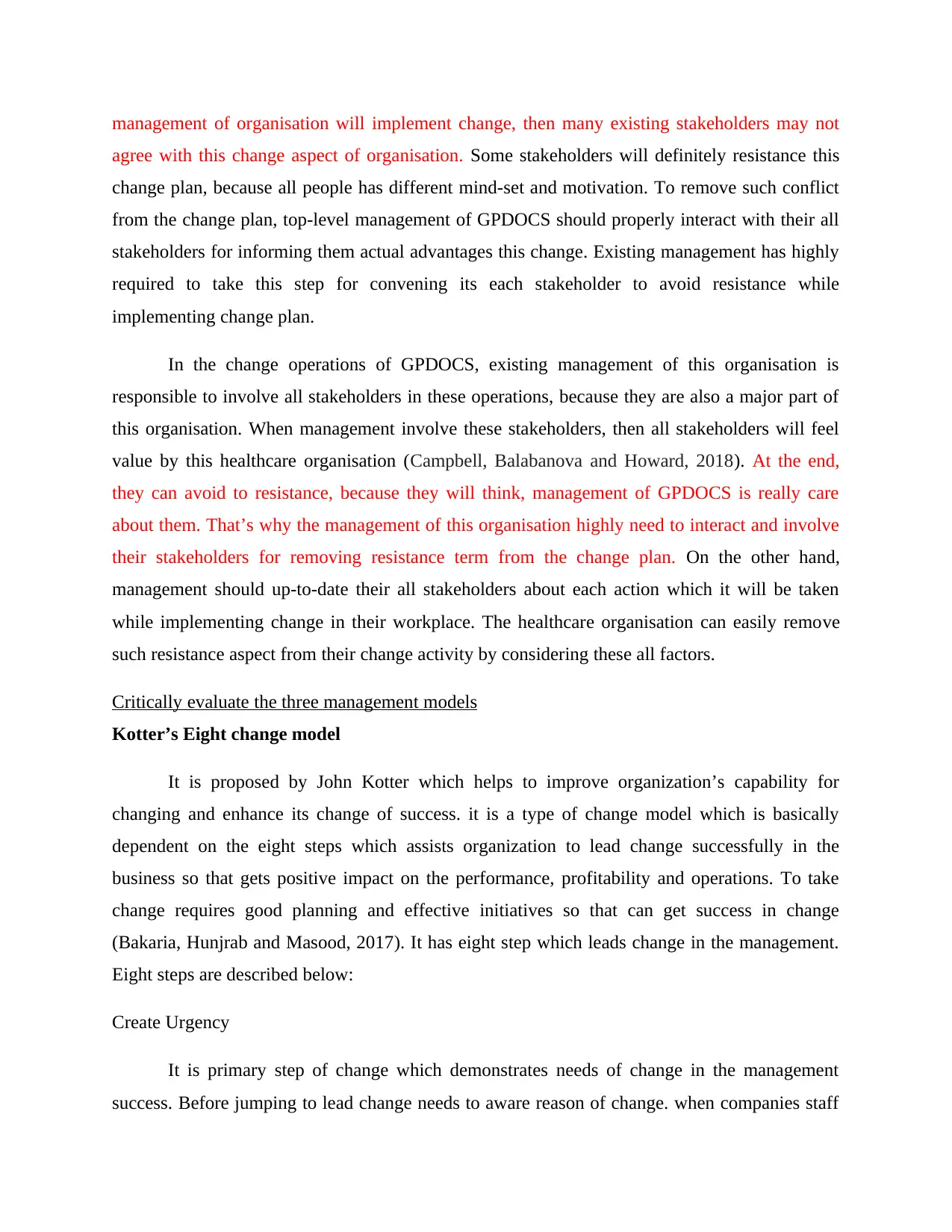
management of organisation will implement change, then many existing stakeholders may not
agree with this change aspect of organisation. Some stakeholders will definitely resistance this
change plan, because all people has different mind-set and motivation. To remove such conflict
from the change plan, top-level management of GPDOCS should properly interact with their all
stakeholders for informing them actual advantages this change. Existing management has highly
required to take this step for convening its each stakeholder to avoid resistance while
implementing change plan.
In the change operations of GPDOCS, existing management of this organisation is
responsible to involve all stakeholders in these operations, because they are also a major part of
this organisation. When management involve these stakeholders, then all stakeholders will feel
value by this healthcare organisation (Campbell, Balabanova and Howard, 2018). At the end,
they can avoid to resistance, because they will think, management of GPDOCS is really care
about them. That’s why the management of this organisation highly need to interact and involve
their stakeholders for removing resistance term from the change plan. On the other hand,
management should up-to-date their all stakeholders about each action which it will be taken
while implementing change in their workplace. The healthcare organisation can easily remove
such resistance aspect from their change activity by considering these all factors.
Critically evaluate the three management models
Kotter’s Eight change model
It is proposed by John Kotter which helps to improve organization’s capability for
changing and enhance its change of success. it is a type of change model which is basically
dependent on the eight steps which assists organization to lead change successfully in the
business so that gets positive impact on the performance, profitability and operations. To take
change requires good planning and effective initiatives so that can get success in change
(Bakaria, Hunjrab and Masood, 2017). It has eight step which leads change in the management.
Eight steps are described below:
Create Urgency
It is primary step of change which demonstrates needs of change in the management
success. Before jumping to lead change needs to aware reason of change. when companies staff
agree with this change aspect of organisation. Some stakeholders will definitely resistance this
change plan, because all people has different mind-set and motivation. To remove such conflict
from the change plan, top-level management of GPDOCS should properly interact with their all
stakeholders for informing them actual advantages this change. Existing management has highly
required to take this step for convening its each stakeholder to avoid resistance while
implementing change plan.
In the change operations of GPDOCS, existing management of this organisation is
responsible to involve all stakeholders in these operations, because they are also a major part of
this organisation. When management involve these stakeholders, then all stakeholders will feel
value by this healthcare organisation (Campbell, Balabanova and Howard, 2018). At the end,
they can avoid to resistance, because they will think, management of GPDOCS is really care
about them. That’s why the management of this organisation highly need to interact and involve
their stakeholders for removing resistance term from the change plan. On the other hand,
management should up-to-date their all stakeholders about each action which it will be taken
while implementing change in their workplace. The healthcare organisation can easily remove
such resistance aspect from their change activity by considering these all factors.
Critically evaluate the three management models
Kotter’s Eight change model
It is proposed by John Kotter which helps to improve organization’s capability for
changing and enhance its change of success. it is a type of change model which is basically
dependent on the eight steps which assists organization to lead change successfully in the
business so that gets positive impact on the performance, profitability and operations. To take
change requires good planning and effective initiatives so that can get success in change
(Bakaria, Hunjrab and Masood, 2017). It has eight step which leads change in the management.
Eight steps are described below:
Create Urgency
It is primary step of change which demonstrates needs of change in the management
success. Before jumping to lead change needs to aware reason of change. when companies staff
⊘ This is a preview!⊘
Do you want full access?
Subscribe today to unlock all pages.

Trusted by 1+ million students worldwide
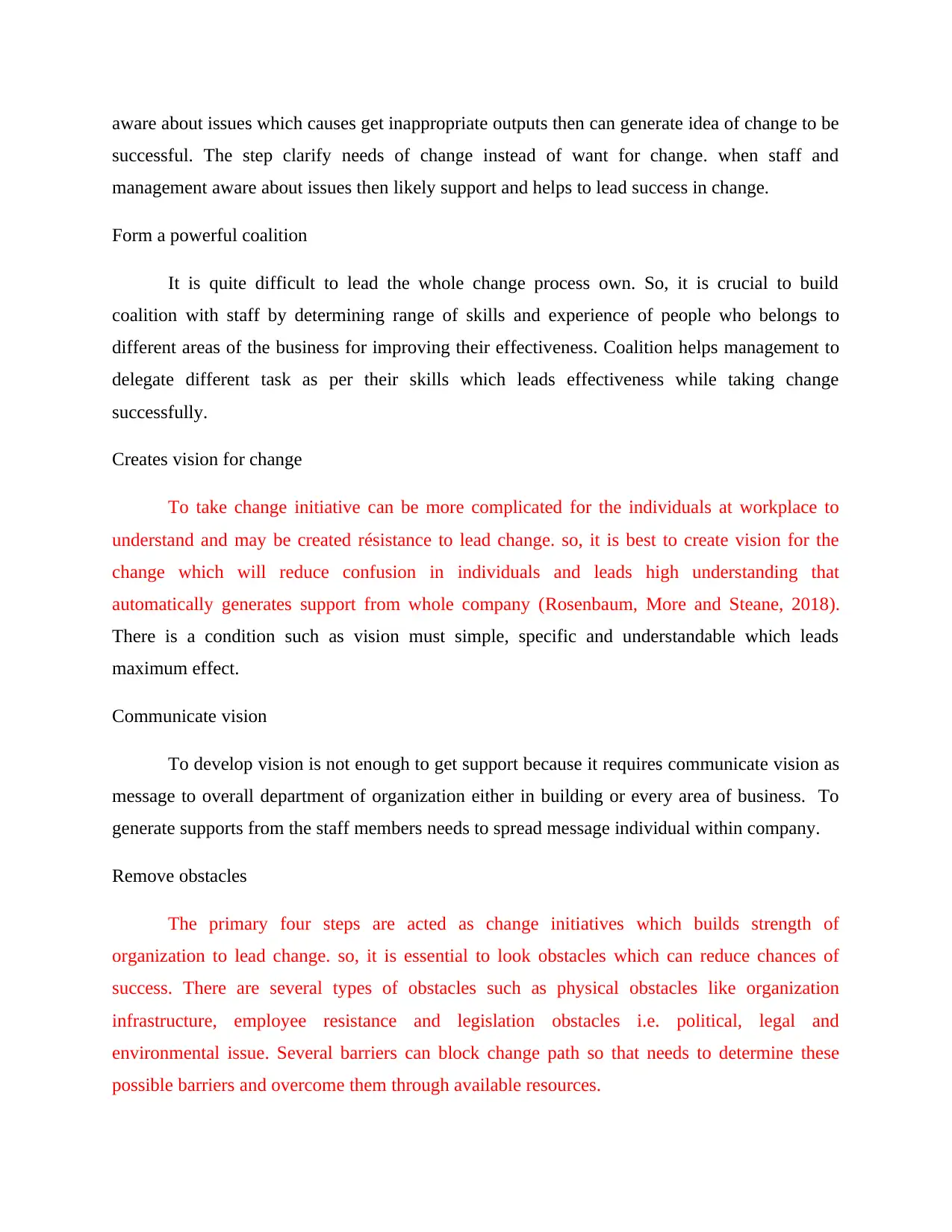
aware about issues which causes get inappropriate outputs then can generate idea of change to be
successful. The step clarify needs of change instead of want for change. when staff and
management aware about issues then likely support and helps to lead success in change.
Form a powerful coalition
It is quite difficult to lead the whole change process own. So, it is crucial to build
coalition with staff by determining range of skills and experience of people who belongs to
different areas of the business for improving their effectiveness. Coalition helps management to
delegate different task as per their skills which leads effectiveness while taking change
successfully.
Creates vision for change
To take change initiative can be more complicated for the individuals at workplace to
understand and may be created résistance to lead change. so, it is best to create vision for the
change which will reduce confusion in individuals and leads high understanding that
automatically generates support from whole company (Rosenbaum, More and Steane, 2018).
There is a condition such as vision must simple, specific and understandable which leads
maximum effect.
Communicate vision
To develop vision is not enough to get support because it requires communicate vision as
message to overall department of organization either in building or every area of business. To
generate supports from the staff members needs to spread message individual within company.
Remove obstacles
The primary four steps are acted as change initiatives which builds strength of
organization to lead change. so, it is essential to look obstacles which can reduce chances of
success. There are several types of obstacles such as physical obstacles like organization
infrastructure, employee resistance and legislation obstacles i.e. political, legal and
environmental issue. Several barriers can block change path so that needs to determine these
possible barriers and overcome them through available resources.
successful. The step clarify needs of change instead of want for change. when staff and
management aware about issues then likely support and helps to lead success in change.
Form a powerful coalition
It is quite difficult to lead the whole change process own. So, it is crucial to build
coalition with staff by determining range of skills and experience of people who belongs to
different areas of the business for improving their effectiveness. Coalition helps management to
delegate different task as per their skills which leads effectiveness while taking change
successfully.
Creates vision for change
To take change initiative can be more complicated for the individuals at workplace to
understand and may be created résistance to lead change. so, it is best to create vision for the
change which will reduce confusion in individuals and leads high understanding that
automatically generates support from whole company (Rosenbaum, More and Steane, 2018).
There is a condition such as vision must simple, specific and understandable which leads
maximum effect.
Communicate vision
To develop vision is not enough to get support because it requires communicate vision as
message to overall department of organization either in building or every area of business. To
generate supports from the staff members needs to spread message individual within company.
Remove obstacles
The primary four steps are acted as change initiatives which builds strength of
organization to lead change. so, it is essential to look obstacles which can reduce chances of
success. There are several types of obstacles such as physical obstacles like organization
infrastructure, employee resistance and legislation obstacles i.e. political, legal and
environmental issue. Several barriers can block change path so that needs to determine these
possible barriers and overcome them through available resources.
Paraphrase This Document
Need a fresh take? Get an instant paraphrase of this document with our AI Paraphraser
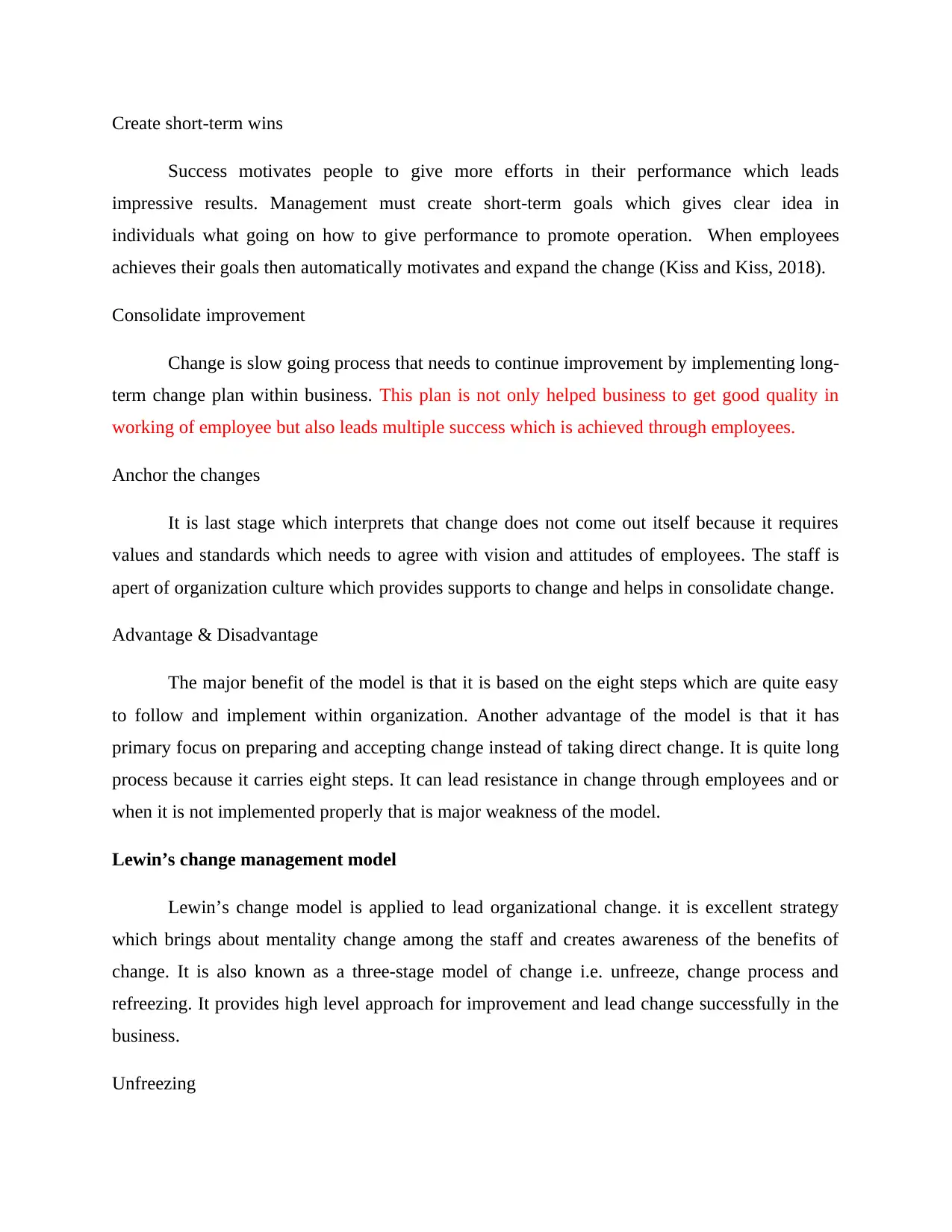
Create short-term wins
Success motivates people to give more efforts in their performance which leads
impressive results. Management must create short-term goals which gives clear idea in
individuals what going on how to give performance to promote operation. When employees
achieves their goals then automatically motivates and expand the change (Kiss and Kiss, 2018).
Consolidate improvement
Change is slow going process that needs to continue improvement by implementing long-
term change plan within business. This plan is not only helped business to get good quality in
working of employee but also leads multiple success which is achieved through employees.
Anchor the changes
It is last stage which interprets that change does not come out itself because it requires
values and standards which needs to agree with vision and attitudes of employees. The staff is
apert of organization culture which provides supports to change and helps in consolidate change.
Advantage & Disadvantage
The major benefit of the model is that it is based on the eight steps which are quite easy
to follow and implement within organization. Another advantage of the model is that it has
primary focus on preparing and accepting change instead of taking direct change. It is quite long
process because it carries eight steps. It can lead resistance in change through employees and or
when it is not implemented properly that is major weakness of the model.
Lewin’s change management model
Lewin’s change model is applied to lead organizational change. it is excellent strategy
which brings about mentality change among the staff and creates awareness of the benefits of
change. It is also known as a three-stage model of change i.e. unfreeze, change process and
refreezing. It provides high level approach for improvement and lead change successfully in the
business.
Unfreezing
Success motivates people to give more efforts in their performance which leads
impressive results. Management must create short-term goals which gives clear idea in
individuals what going on how to give performance to promote operation. When employees
achieves their goals then automatically motivates and expand the change (Kiss and Kiss, 2018).
Consolidate improvement
Change is slow going process that needs to continue improvement by implementing long-
term change plan within business. This plan is not only helped business to get good quality in
working of employee but also leads multiple success which is achieved through employees.
Anchor the changes
It is last stage which interprets that change does not come out itself because it requires
values and standards which needs to agree with vision and attitudes of employees. The staff is
apert of organization culture which provides supports to change and helps in consolidate change.
Advantage & Disadvantage
The major benefit of the model is that it is based on the eight steps which are quite easy
to follow and implement within organization. Another advantage of the model is that it has
primary focus on preparing and accepting change instead of taking direct change. It is quite long
process because it carries eight steps. It can lead resistance in change through employees and or
when it is not implemented properly that is major weakness of the model.
Lewin’s change management model
Lewin’s change model is applied to lead organizational change. it is excellent strategy
which brings about mentality change among the staff and creates awareness of the benefits of
change. It is also known as a three-stage model of change i.e. unfreeze, change process and
refreezing. It provides high level approach for improvement and lead change successfully in the
business.
Unfreezing
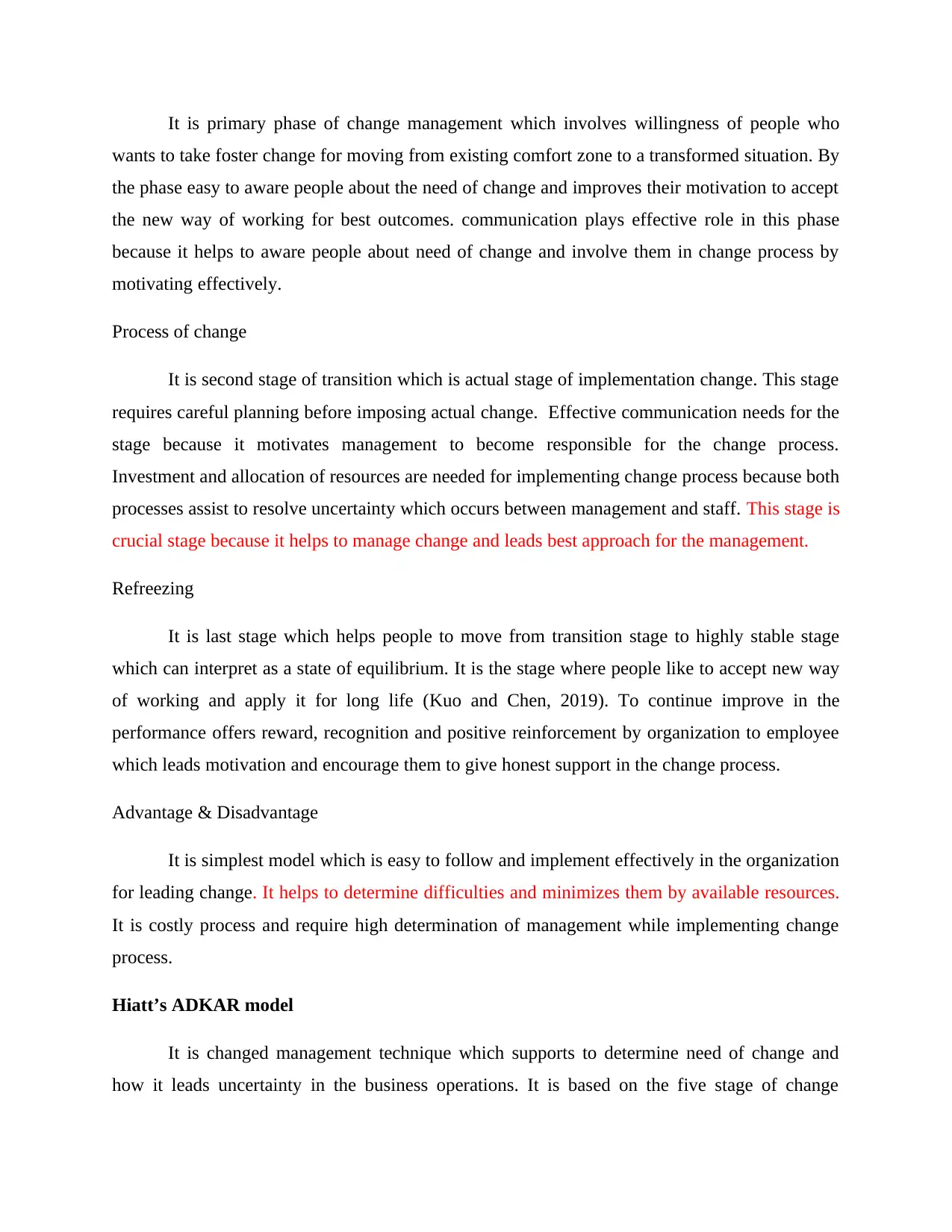
It is primary phase of change management which involves willingness of people who
wants to take foster change for moving from existing comfort zone to a transformed situation. By
the phase easy to aware people about the need of change and improves their motivation to accept
the new way of working for best outcomes. communication plays effective role in this phase
because it helps to aware people about need of change and involve them in change process by
motivating effectively.
Process of change
It is second stage of transition which is actual stage of implementation change. This stage
requires careful planning before imposing actual change. Effective communication needs for the
stage because it motivates management to become responsible for the change process.
Investment and allocation of resources are needed for implementing change process because both
processes assist to resolve uncertainty which occurs between management and staff. This stage is
crucial stage because it helps to manage change and leads best approach for the management.
Refreezing
It is last stage which helps people to move from transition stage to highly stable stage
which can interpret as a state of equilibrium. It is the stage where people like to accept new way
of working and apply it for long life (Kuo and Chen, 2019). To continue improve in the
performance offers reward, recognition and positive reinforcement by organization to employee
which leads motivation and encourage them to give honest support in the change process.
Advantage & Disadvantage
It is simplest model which is easy to follow and implement effectively in the organization
for leading change. It helps to determine difficulties and minimizes them by available resources.
It is costly process and require high determination of management while implementing change
process.
Hiatt’s ADKAR model
It is changed management technique which supports to determine need of change and
how it leads uncertainty in the business operations. It is based on the five stage of change
wants to take foster change for moving from existing comfort zone to a transformed situation. By
the phase easy to aware people about the need of change and improves their motivation to accept
the new way of working for best outcomes. communication plays effective role in this phase
because it helps to aware people about need of change and involve them in change process by
motivating effectively.
Process of change
It is second stage of transition which is actual stage of implementation change. This stage
requires careful planning before imposing actual change. Effective communication needs for the
stage because it motivates management to become responsible for the change process.
Investment and allocation of resources are needed for implementing change process because both
processes assist to resolve uncertainty which occurs between management and staff. This stage is
crucial stage because it helps to manage change and leads best approach for the management.
Refreezing
It is last stage which helps people to move from transition stage to highly stable stage
which can interpret as a state of equilibrium. It is the stage where people like to accept new way
of working and apply it for long life (Kuo and Chen, 2019). To continue improve in the
performance offers reward, recognition and positive reinforcement by organization to employee
which leads motivation and encourage them to give honest support in the change process.
Advantage & Disadvantage
It is simplest model which is easy to follow and implement effectively in the organization
for leading change. It helps to determine difficulties and minimizes them by available resources.
It is costly process and require high determination of management while implementing change
process.
Hiatt’s ADKAR model
It is changed management technique which supports to determine need of change and
how it leads uncertainty in the business operations. It is based on the five stage of change
⊘ This is a preview!⊘
Do you want full access?
Subscribe today to unlock all pages.

Trusted by 1+ million students worldwide
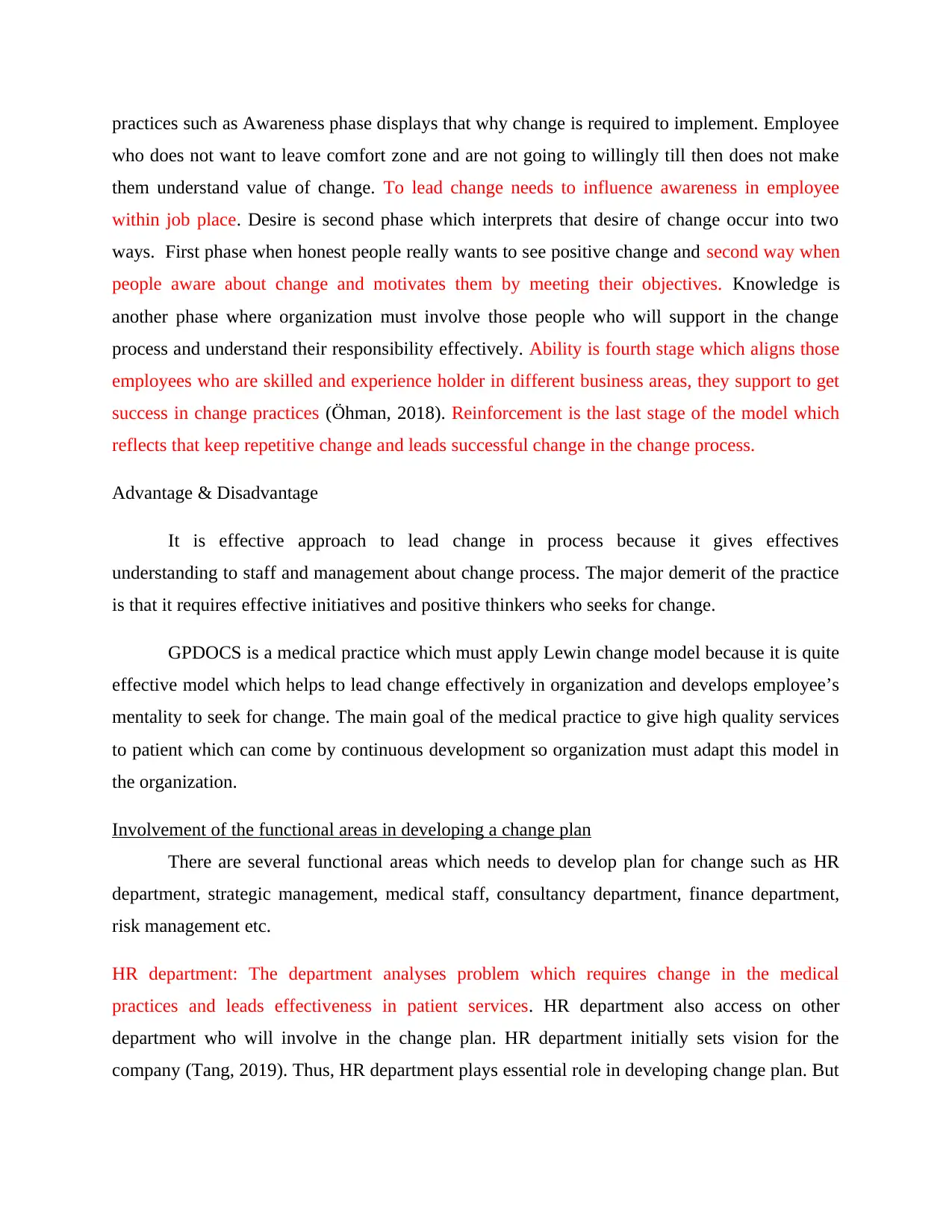
practices such as Awareness phase displays that why change is required to implement. Employee
who does not want to leave comfort zone and are not going to willingly till then does not make
them understand value of change. To lead change needs to influence awareness in employee
within job place. Desire is second phase which interprets that desire of change occur into two
ways. First phase when honest people really wants to see positive change and second way when
people aware about change and motivates them by meeting their objectives. Knowledge is
another phase where organization must involve those people who will support in the change
process and understand their responsibility effectively. Ability is fourth stage which aligns those
employees who are skilled and experience holder in different business areas, they support to get
success in change practices (Öhman, 2018). Reinforcement is the last stage of the model which
reflects that keep repetitive change and leads successful change in the change process.
Advantage & Disadvantage
It is effective approach to lead change in process because it gives effectives
understanding to staff and management about change process. The major demerit of the practice
is that it requires effective initiatives and positive thinkers who seeks for change.
GPDOCS is a medical practice which must apply Lewin change model because it is quite
effective model which helps to lead change effectively in organization and develops employee’s
mentality to seek for change. The main goal of the medical practice to give high quality services
to patient which can come by continuous development so organization must adapt this model in
the organization.
Involvement of the functional areas in developing a change plan
There are several functional areas which needs to develop plan for change such as HR
department, strategic management, medical staff, consultancy department, finance department,
risk management etc.
HR department: The department analyses problem which requires change in the medical
practices and leads effectiveness in patient services. HR department also access on other
department who will involve in the change plan. HR department initially sets vision for the
company (Tang, 2019). Thus, HR department plays essential role in developing change plan. But
who does not want to leave comfort zone and are not going to willingly till then does not make
them understand value of change. To lead change needs to influence awareness in employee
within job place. Desire is second phase which interprets that desire of change occur into two
ways. First phase when honest people really wants to see positive change and second way when
people aware about change and motivates them by meeting their objectives. Knowledge is
another phase where organization must involve those people who will support in the change
process and understand their responsibility effectively. Ability is fourth stage which aligns those
employees who are skilled and experience holder in different business areas, they support to get
success in change practices (Öhman, 2018). Reinforcement is the last stage of the model which
reflects that keep repetitive change and leads successful change in the change process.
Advantage & Disadvantage
It is effective approach to lead change in process because it gives effectives
understanding to staff and management about change process. The major demerit of the practice
is that it requires effective initiatives and positive thinkers who seeks for change.
GPDOCS is a medical practice which must apply Lewin change model because it is quite
effective model which helps to lead change effectively in organization and develops employee’s
mentality to seek for change. The main goal of the medical practice to give high quality services
to patient which can come by continuous development so organization must adapt this model in
the organization.
Involvement of the functional areas in developing a change plan
There are several functional areas which needs to develop plan for change such as HR
department, strategic management, medical staff, consultancy department, finance department,
risk management etc.
HR department: The department analyses problem which requires change in the medical
practices and leads effectiveness in patient services. HR department also access on other
department who will involve in the change plan. HR department initially sets vision for the
company (Tang, 2019). Thus, HR department plays essential role in developing change plan. But
Paraphrase This Document
Need a fresh take? Get an instant paraphrase of this document with our AI Paraphraser
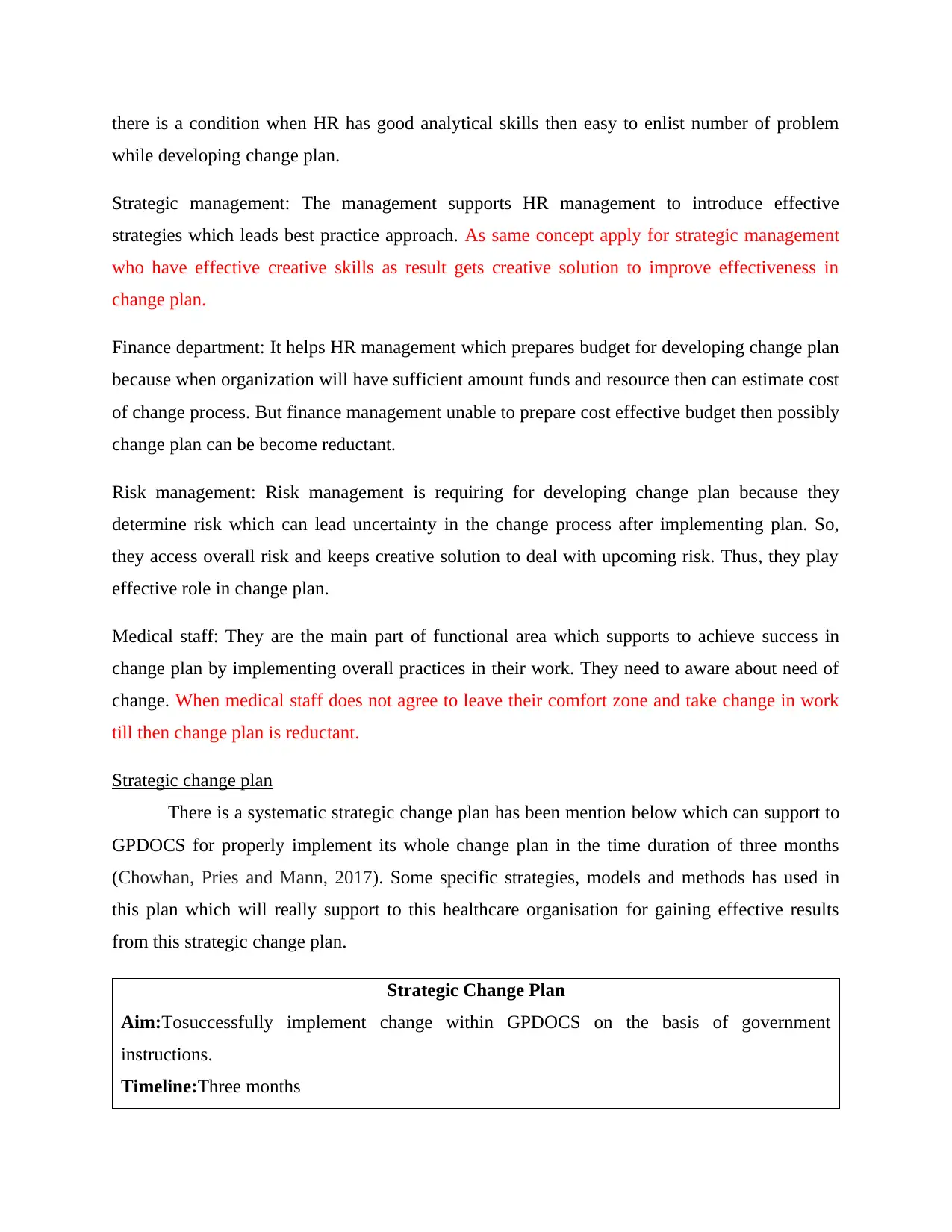
there is a condition when HR has good analytical skills then easy to enlist number of problem
while developing change plan.
Strategic management: The management supports HR management to introduce effective
strategies which leads best practice approach. As same concept apply for strategic management
who have effective creative skills as result gets creative solution to improve effectiveness in
change plan.
Finance department: It helps HR management which prepares budget for developing change plan
because when organization will have sufficient amount funds and resource then can estimate cost
of change process. But finance management unable to prepare cost effective budget then possibly
change plan can be become reductant.
Risk management: Risk management is requiring for developing change plan because they
determine risk which can lead uncertainty in the change process after implementing plan. So,
they access overall risk and keeps creative solution to deal with upcoming risk. Thus, they play
effective role in change plan.
Medical staff: They are the main part of functional area which supports to achieve success in
change plan by implementing overall practices in their work. They need to aware about need of
change. When medical staff does not agree to leave their comfort zone and take change in work
till then change plan is reductant.
Strategic change plan
There is a systematic strategic change plan has been mention below which can support to
GPDOCS for properly implement its whole change plan in the time duration of three months
(Chowhan, Pries and Mann, 2017). Some specific strategies, models and methods has used in
this plan which will really support to this healthcare organisation for gaining effective results
from this strategic change plan.
Strategic Change Plan
Aim:Tosuccessfully implement change within GPDOCS on the basis of government
instructions.
Timeline:Three months
while developing change plan.
Strategic management: The management supports HR management to introduce effective
strategies which leads best practice approach. As same concept apply for strategic management
who have effective creative skills as result gets creative solution to improve effectiveness in
change plan.
Finance department: It helps HR management which prepares budget for developing change plan
because when organization will have sufficient amount funds and resource then can estimate cost
of change process. But finance management unable to prepare cost effective budget then possibly
change plan can be become reductant.
Risk management: Risk management is requiring for developing change plan because they
determine risk which can lead uncertainty in the change process after implementing plan. So,
they access overall risk and keeps creative solution to deal with upcoming risk. Thus, they play
effective role in change plan.
Medical staff: They are the main part of functional area which supports to achieve success in
change plan by implementing overall practices in their work. They need to aware about need of
change. When medical staff does not agree to leave their comfort zone and take change in work
till then change plan is reductant.
Strategic change plan
There is a systematic strategic change plan has been mention below which can support to
GPDOCS for properly implement its whole change plan in the time duration of three months
(Chowhan, Pries and Mann, 2017). Some specific strategies, models and methods has used in
this plan which will really support to this healthcare organisation for gaining effective results
from this strategic change plan.
Strategic Change Plan
Aim:Tosuccessfully implement change within GPDOCS on the basis of government
instructions.
Timeline:Three months
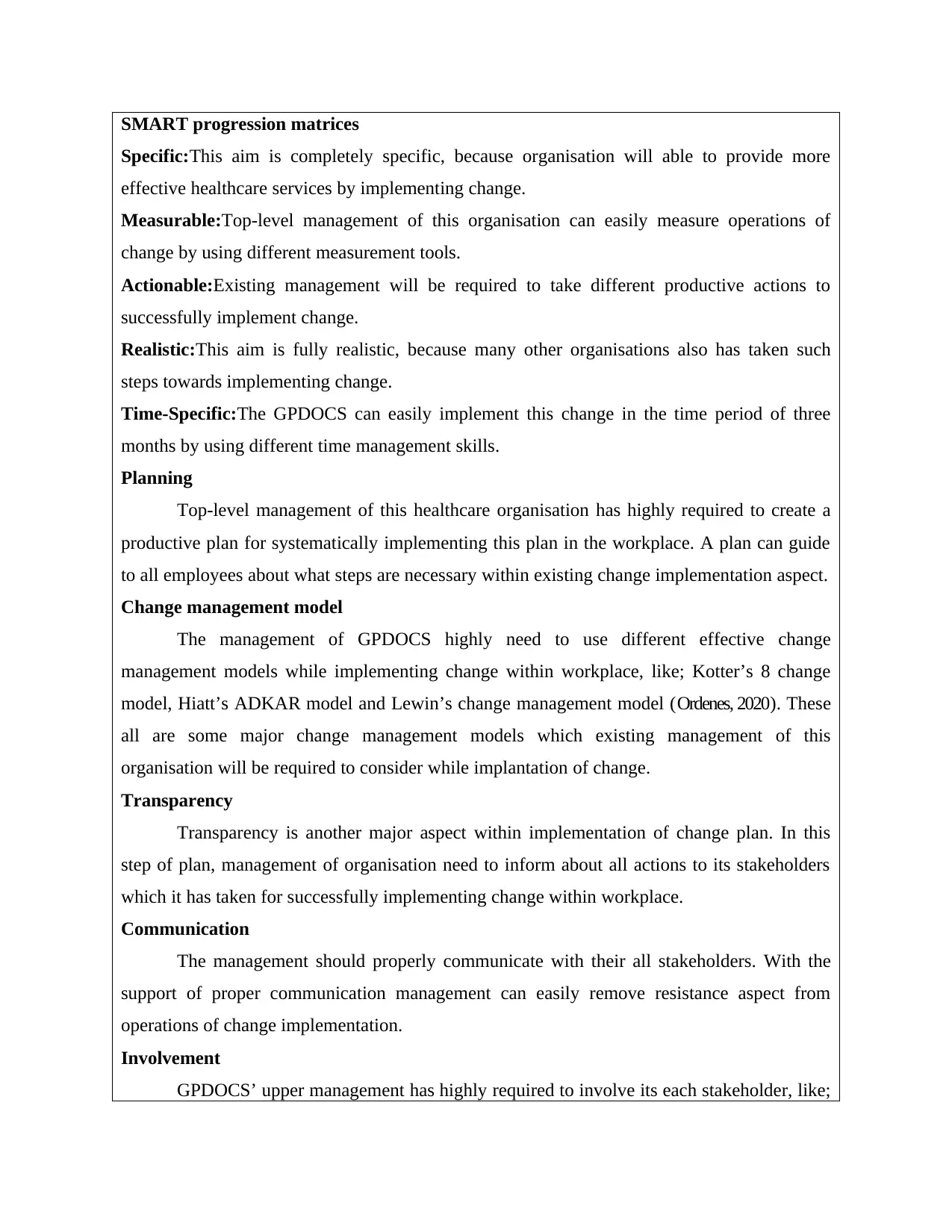
SMART progression matrices
Specific:This aim is completely specific, because organisation will able to provide more
effective healthcare services by implementing change.
Measurable:Top-level management of this organisation can easily measure operations of
change by using different measurement tools.
Actionable:Existing management will be required to take different productive actions to
successfully implement change.
Realistic:This aim is fully realistic, because many other organisations also has taken such
steps towards implementing change.
Time-Specific:The GPDOCS can easily implement this change in the time period of three
months by using different time management skills.
Planning
Top-level management of this healthcare organisation has highly required to create a
productive plan for systematically implementing this plan in the workplace. A plan can guide
to all employees about what steps are necessary within existing change implementation aspect.
Change management model
The management of GPDOCS highly need to use different effective change
management models while implementing change within workplace, like; Kotter’s 8 change
model, Hiatt’s ADKAR model and Lewin’s change management model (Ordenes, 2020). These
all are some major change management models which existing management of this
organisation will be required to consider while implantation of change.
Transparency
Transparency is another major aspect within implementation of change plan. In this
step of plan, management of organisation need to inform about all actions to its stakeholders
which it has taken for successfully implementing change within workplace.
Communication
The management should properly communicate with their all stakeholders. With the
support of proper communication management can easily remove resistance aspect from
operations of change implementation.
Involvement
GPDOCS’ upper management has highly required to involve its each stakeholder, like;
Specific:This aim is completely specific, because organisation will able to provide more
effective healthcare services by implementing change.
Measurable:Top-level management of this organisation can easily measure operations of
change by using different measurement tools.
Actionable:Existing management will be required to take different productive actions to
successfully implement change.
Realistic:This aim is fully realistic, because many other organisations also has taken such
steps towards implementing change.
Time-Specific:The GPDOCS can easily implement this change in the time period of three
months by using different time management skills.
Planning
Top-level management of this healthcare organisation has highly required to create a
productive plan for systematically implementing this plan in the workplace. A plan can guide
to all employees about what steps are necessary within existing change implementation aspect.
Change management model
The management of GPDOCS highly need to use different effective change
management models while implementing change within workplace, like; Kotter’s 8 change
model, Hiatt’s ADKAR model and Lewin’s change management model (Ordenes, 2020). These
all are some major change management models which existing management of this
organisation will be required to consider while implantation of change.
Transparency
Transparency is another major aspect within implementation of change plan. In this
step of plan, management of organisation need to inform about all actions to its stakeholders
which it has taken for successfully implementing change within workplace.
Communication
The management should properly communicate with their all stakeholders. With the
support of proper communication management can easily remove resistance aspect from
operations of change implementation.
Involvement
GPDOCS’ upper management has highly required to involve its each stakeholder, like;
⊘ This is a preview!⊘
Do you want full access?
Subscribe today to unlock all pages.

Trusted by 1+ million students worldwide
1 out of 19
Related Documents
Your All-in-One AI-Powered Toolkit for Academic Success.
+13062052269
info@desklib.com
Available 24*7 on WhatsApp / Email
![[object Object]](/_next/static/media/star-bottom.7253800d.svg)
Unlock your academic potential
Copyright © 2020–2025 A2Z Services. All Rights Reserved. Developed and managed by ZUCOL.





